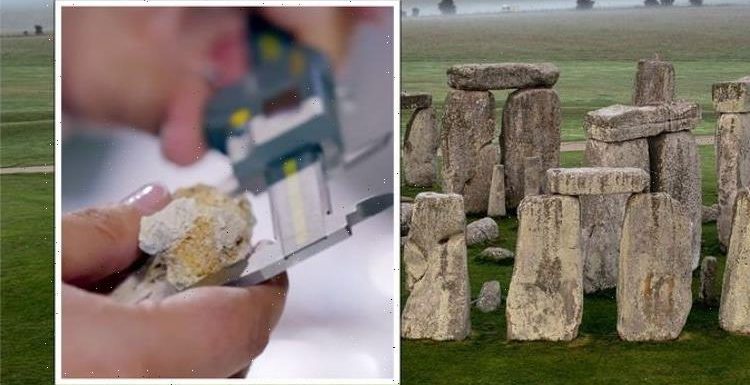
Stonehenge: Osteoarchaeologist discusses find of human bones
We use your sign-up to provide content in ways you’ve consented to and to improve our understanding of you. This may include adverts from us and 3rd parties based on our understanding. You can unsubscribe at any time. More info
England’s most famous stone circle has long since captivated the imaginations of millions around the world. Earlier this year, researchers came a step closer to solving the mystery behind the man-made rock formation after uncovering the remains of the Waun Main site in Pembrokeshire’s Preseli Hills, southwest Wales. It soon proved to be one of Britain’s biggest and oldest stone circles, and could be the original building blocks of Stonehenge.
Researchers believe the stones could have been dismantled and rebuilt 150 miles away on Salisbury Plain, Wiltshire, where the structure stands today and has stood, it is believed, since as far back as 3000 BC.
This came as a breakthrough, yet archaeologists are still not fully sure what purpose Stonehenge served.
There is strong evidence, however, that it was used as a burial site, with remains from an excavation just a few miles away and at the site itself explored during the Smithsonian channel’s documentary, ‘Secrets: Stonehenge Mystery’, which it described as an “elite cemetery”.
As a result of the find, the documentary’s narrator noted: “The 4,5000-year history of Stonehenge is being reshaped.”


At a Stone Age village found just two miles away, near the Durrington Walls and banks of the River Avon, archaeologists found that the villagers at the settlement “hosted the builders” of the monument.
They were “a group of people who came from all over Britain to erect the stones and celebrate the winter solstice with epic feasts.”
Archaeologist Mike Parker Pearson from University College London (UCL) said: “Stonehenge wasn’t simply a local monument for local people, this was something that involved people from miles and miles away.”
As part of the excavations, half a million bone fragments were found scattered around the stones, and could, researchers believe, hold the key to understanding why the remote part of England was picked as the site for such a monument of significance.
JUST IN: Roman Empire in UK ‘rewritten’ after ‘gladiator’ grave found

Mr Pearson said: “What we’ve discovered is that it’s actually the biggest cemetery that we have anywhere in Britain throughout the whole of the Third Millennium BC.”
The earliest bones were buried around 3,000 BC — 500 years before Stonehenge as we know it today was even erected.
Christie Willis, a bioarchaeologist at UCL, told the documentary: “These results, not only did they rewrite what we knew about Stonehenge, but they rewrote what we knew about Neolithic Britain.”
Researchers began to question whether the mass cemetery was the reason why Stonehenge was built — a monument to the countless dead.
DON’T MISS
Archaeologists thrilled as HS2 works uncover Anglo-Saxon church ruins [REPORT]
End of the world: Date when Sun will die pinpointed [ANALYSIS]
Archaeology: Skeletons of people behind ‘origins of England’ unearthed [INSIGHT]


But this would suggest that those buried were of a more significant class than the ordinary Neolithic man and woman.
Analysing the burial ground, archaeologists looked for evidence of brutal deaths and violent combat, clean breaks of bones and the remnants of arrowheads, all hallmarks of ancient burials of warriors.
Yet, there was no evidence for any kind of violence on the bones.
The variety of bones also astounded the archaeologists: from big to small, they hinted at how the Neolithic peoples honoured their dead.

And each burnt fragment of bone at Stonehenge had been meticulously collected and treated with the greatest care.
It suggested what linked the burials was a status and respect these people commanded in life.
Researchers concluded that those buried there were of high-standing in Stone Age society, the elites of their times.

Despite this breakthrough, the exact identity of those who built the Stonehenge remains a mystery.
People back then were hand-to-mouth subsistence farmers, technologically undeveloped, just starting to understand how to work with metal.
The fact has eluded researchers for decades, that these people managed to transport and construct such a feat of engineering.
How they might have delivered the now famous bluestone from south west Wales to Salisbury is another mystery.
Source: Read Full Article